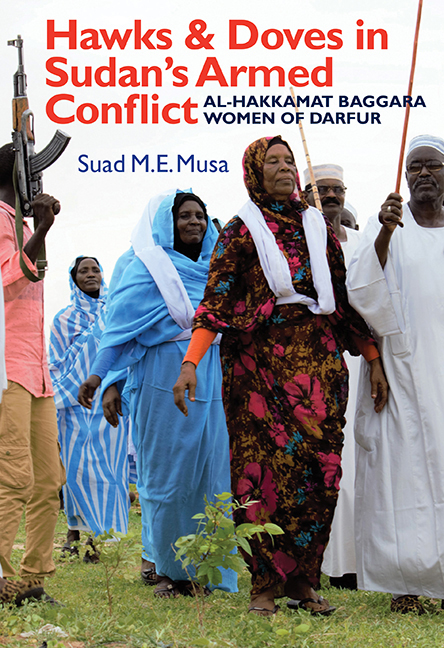Book contents
- Frontmatter
- Dedication
- Contents
- List of Illustrations
- Acknowledgements
- Glossary
- Abbreviations
- Note on Transliteration
- Introduction: Conflict in Darfur and the Role of Rural Darfuri Women
- 1 Ethnicity and Administration in Darfur
- 2 Conflict in Darfur: Causes and Implications
- 3 Al-Hakkamat Women
- 4 Local Inter-ethnic Conflicts
- 5 Government and Racial Assimilation of Ethnic Groups
- 6 Liaising with Government
- 7 New Duties and Obligations
- 8 Roles in Peace and Reconciliation
- 9 Urban Identity and Social Change
- 10 Conclusion
- Appendix: Darfur Chronology, 1445–2017
- Bibliography
- Index
- Eastern African Studies
8 - Roles in Peace and Reconciliation
Published online by Cambridge University Press: 12 October 2019
- Frontmatter
- Dedication
- Contents
- List of Illustrations
- Acknowledgements
- Glossary
- Abbreviations
- Note on Transliteration
- Introduction: Conflict in Darfur and the Role of Rural Darfuri Women
- 1 Ethnicity and Administration in Darfur
- 2 Conflict in Darfur: Causes and Implications
- 3 Al-Hakkamat Women
- 4 Local Inter-ethnic Conflicts
- 5 Government and Racial Assimilation of Ethnic Groups
- 6 Liaising with Government
- 7 New Duties and Obligations
- 8 Roles in Peace and Reconciliation
- 9 Urban Identity and Social Change
- 10 Conclusion
- Appendix: Darfur Chronology, 1445–2017
- Bibliography
- Index
- Eastern African Studies
Summary
Investigating violent armed conflict and wars in Sudan has revealed that rural women, Darfuris in particular, were most affected; women became vulnerable victims of the atrocities of war, including gender-based violence that left women at the head of 70 per cent of households (El Hassan, 2008). This bitter experience undoubtedly makes them the most aspirant gender to stop war in favour of reconciliation and peace. Al-Hakkamat's tremendous contribution to inciting conflict, making war and creating dire situations that primarily affect women presupposes a pivotal need for their engagement in reconciliation and peace processes. However, they have been ordinarily dissociated from peace initiatives attempted in Darfur as we now going to explain.
WOMEN AND AL-HAKKAMAT IN PEACE AND RECONCILIATION
The people of Darfur, according to the prevailing culture in most African societies, have their own historical indigenous mechanisms for conflict resolution and resettlement of disputes locally referred to as Ajaweed (single: Ajwadi), which functions as a native arbitration court/council dealing with individual and tribal conflict. It is one of the lasting cultures that still prevails in Darfur.
The Ajaweed comprises a voluntary group of wise elderly men who are skilful, knowledgeable and well versed in various aspects of the society. They use their lifelong expertise and persuasive abilities to advocate instantly and to impartially resolve conflicts between tribes or among individuals that are brought to their attention. The council runs its activities through a meeting board called judiyah (traditional mediation). In their arbitrations, the judiyah is guided by the local customs and norms, known as ʾaʿrāf (conventions), or rākūbah (shelter). These conventions and customs have the Canon of Dali (Qanoon Dali) or Dali Code as a common legislative reference adopted during the Fur sultanate in which local customs are incorporated with the Islamic shari'a commandments (Mohamed and Badri, 2005, p. 52; Kamal El-Din, 2007, pp. 93–4).
During the colonial period (1921–33), the government introduced the so-called ‘government-sponsored judiyah’ as part of the newly introduced native administration system in which the Nazir, the Omda and the Sheikh were included as members. Despite this interference, by and large the Ajaweed retained its structure and mechanism, as the governmental presence was only nominal.
- Type
- Chapter
- Information
- Hawks and Doves in Sudan's Armed ConflictAl-Hakkamat Baggara Women of Darfur, pp. 150 - 166Publisher: Boydell & BrewerPrint publication year: 2018

